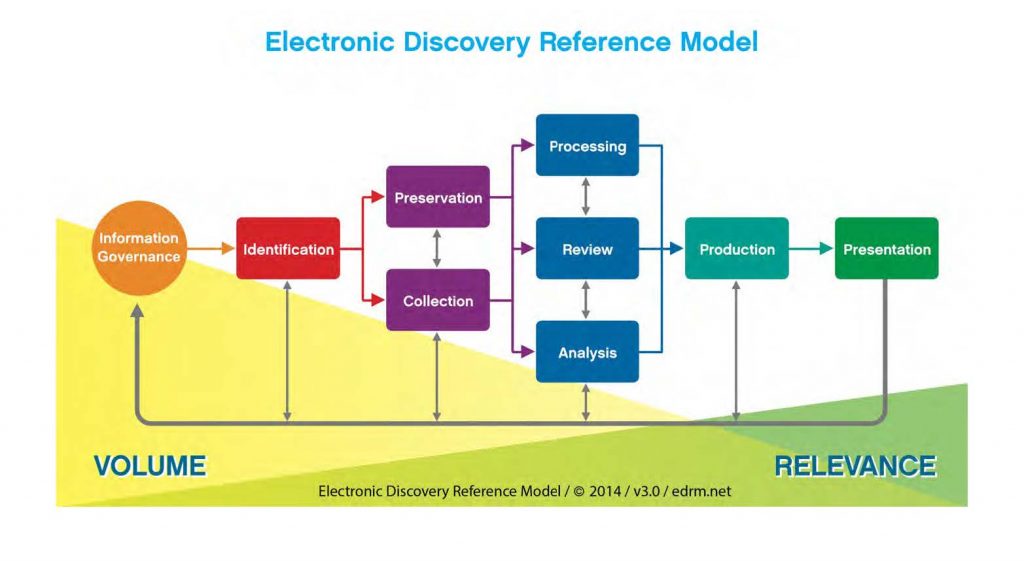Cyberlaw
e-Discovery and redaction
According to EDRM, a somewhat informal industry standard group, maintained by the Duke Law Center for Judicial Studies, to develop and publish frameworks, standards, and resources that address practical issues relating to e-discovery and information governance, the goal of document production in the world of electronically stored information (ESI) is to prepare and produce ESI in an efficient and usable format in order to reduce cost, risk and errors and comply with agreed production specifications and timelines.

Many attorneys fail to properly manage discovery and document production in this age of e-discovery. The most common failures by attorneys in document production are ignorance of the federal and state Rules and failing to utilize ‘Meet & Confer’ (Rule 26) opportunities.
Unless you are committed to stone walling and “scorched earth” opposition to all discovery and document production demands, at the first Rule 26 conference make sure to request specific file types and metadata as needed and beware of negotiating incomplete discovery orders.
<h2Redaction Issues and Confidentiality Considerations
Redaction is a critical element of the document discovery process with respect to ESI. It is much more than using the electronic equivalent of a black marking pen.
Beware of the format you use in filing a PDF document in PACER and state ECF systems. Even though the redaction “black boxes” appear in the filed PDF document, when that document is copied and pasted to other programs the black redaction boxes can disappear exposing the redacted information. This occurred in 2018 in the Florida Parkland school shooting criminal case where the redacted material provided to the media became visible as soon as it was recopied to a different computer platform.
More recently, lawyers for Paul Manafort, former campaign manager for President Donald Trump, apparently failed to redact a federal court document properly, permitting the blacked-out text to be viewed “with a few keystrokes” by the media.
The party producing and/or filing a document is responsible for ensuring that it was properly redacted.
The attorney responsible for the ESI production must be sure that the redaction on the image has been adequately “burned-in” and the text files have been updated or subject to re-OCR the to match the redactions.
Counsel is also responsible for redacting certain metadata and not providing un-redacted native files.
Rules for safe redaction
Edit out sensitive information before converting a document to PDF format. Remove the metadata; then convert the document to a non-text, non-editable PDF (image only).
Electronic redaction should be done by a software tool that allows users to burn a permanent black box into an image or text.
When redaction involves paper documents, deleting the redacted material with a razor blade or graphic knife is the only sure method of redacting a copy. Modern high resolution scanners are sensitive enough to reveal covered words.
Lawyers who fail to properly redact documents not only risk civil liability and loss of client confidence, but potential disciplinary sanctions for failing to properly safeguard client property.
Production failures
Many attorneys agree to document production specifications without understanding what they are agreeing to.
One of the specifications is the “load file.” Load files are used to import coded, captured or extracted data from ESI processing into a database. These load files generally carry commands instructing the software to carry out certain functions with the data found in them.
Just as placing data in the wrong row or column of a table renders the table unreliable and potentially unusable, errors in load files render the load file unreliable, and any database it populates is potentially unusable. Just a single absent, misplaced or malformed delimiter can result in numerous data fields being incorrectly populated. Load files have always been an irritant and a hazard; but, they provided a measure of searchability to otherwise unsearchable paper documents.
The meet and confer provisions of Fed. R. Civ. P. Rule 26 provide the opportunity for attorneys to talk through the production protocol and specifications prior to collecting any data.
The time it takes to set-up, convert to the appropriate format and export the final deliverable is vastly underestimated largely because the attorneys are unaware of the amount of data involved. Before agreeing to a scheduling order, make sure you are sure that you and your client can comply with it.
I suggest that any attorney involved in e-discovery should demand ESI production in native format and ignore load files.
The FRE Rule 502(d) Order
Obtain a FRE Rule 502(d) Order protecting against careless or otherwise inadvertent disclosure at the outset of discovery in federal court litigation to whether on consent following a Rule 26 conference or by application to the Magistrate Judge supervising discovery. I believe that failure to obtain a Rule 502(d) Order may even be prima facie evidence of malpractice.
</h2
